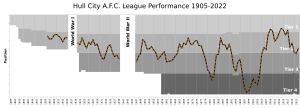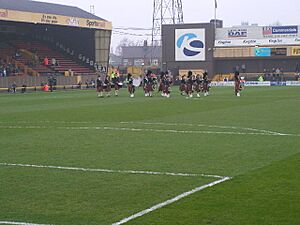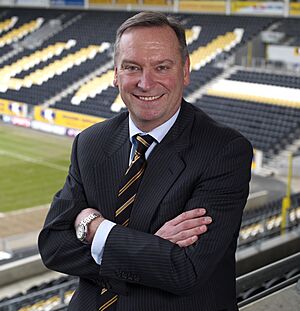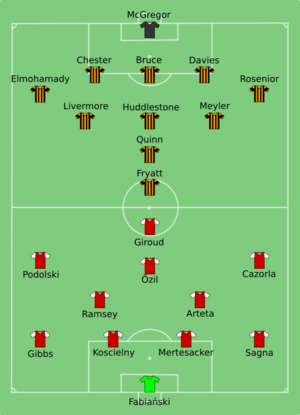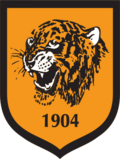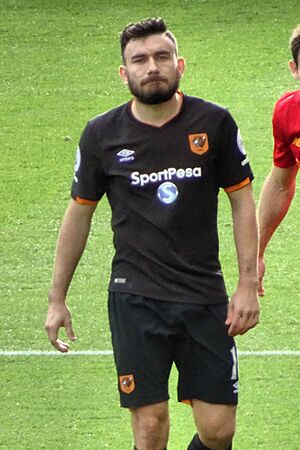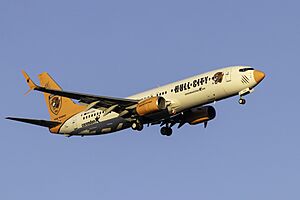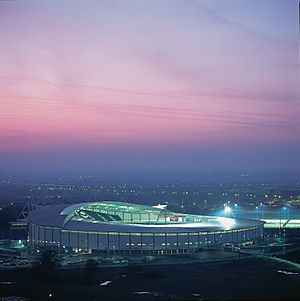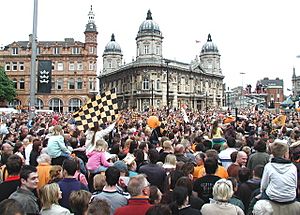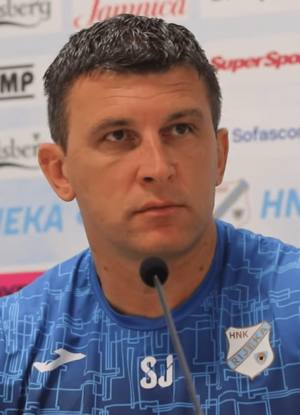Hull City A.F.C. facts for kids
 |
||||
| Full name | Hull City Association Football Club | |||
|---|---|---|---|---|
| Nickname(s) | The Tigers | |||
| Founded | 28 June 1904 | |||
| Ground | MKM Stadium | |||
| Capacity | 25,586 | |||
| Owner | Acun Medya | |||
| Chairman | Acun Ilıcalı | |||
| Head Coach | Sergej Jakirović | |||
| League | Championship | |||
| 2018–19 | Championship, 13th of 24 | |||
|
||||
Hull City Association Football Club is a professional football team from Kingston upon Hull, England. They are often called the Tigers because of their black and amber colours. Hull City plays its home games at the MKM Stadium. They compete in the Championship, which is the second-highest league in English football.
The club started in 1904 and joined the Football League a year later. They have moved between different leagues over the years. In 2008, Hull City reached the Premier League for the first time, which is the top league in England. They also played in their first FA Cup final in 2014, but lost to Arsenal. Hull City has been promoted and relegated several times, earning them the nickname of a "yo-yo club." In 2021, they won the League One title and returned to the Championship.
Contents
Hull City's Journey: A Look at Their History
How Hull City Began (1904–1945)
Hull City Association Football Club was founded on June 28, 1904. At first, it was hard to start a football club in Hull because rugby league was very popular. The city already had two strong rugby teams, Hull F.C. and Hull K.R..
Hull City could not join the Football League right away in 1904. Instead, they played friendly matches. Their first game was a 2–2 draw against Notts County on September 1, 1904. These early games were played at the Boulevard, which was Hull F.C.'s rugby ground. Hull City's first official match was in the FA Cup on September 17, drawing 3–3 with Stockton.
After some issues with their stadium, Hull City moved to the Circle, a local cricket ground. In the 1905–06 season, Hull City joined the Football League Second Division. They played against famous teams like Manchester United and Chelsea. They won their first league game 4–1 against Barnsley and finished 5th that season.
In March 1906, Hull City opened its first permanent home ground, Anlaby Road. The team played there until 1939. Hull City almost got promoted in the 1909–10 season. They finished with the same points as Oldham Athletic but missed out on promotion because of a small difference in "goal average" (how many goals they scored compared to how many they let in).
After World War I, Hull City struggled and was relegated to the Third Division North in 1930. However, they had a great run in the 1929–30 FA Cup. They beat strong teams like Plymouth Argyle, Blackpool, and Manchester City. They reached the semi-finals, where they played against Arsenal. After a 2–2 draw, Arsenal won the replay 1–0, ending Hull's cup journey.
Hull City won their first league title in the 1932–33 season, getting promoted back to the Second Division. They finished just two points ahead of Wrexham. A player named Bill McNaughton was a star that season, scoring 41 goals!
Moving Up and Down the Leagues (1945–1982)
After World War II, Hull City moved to a new stadium called Boothferry Park. In the 1948–49 season, led by player-manager Raich Carter, Hull won promotion from the Third Division North again.
Hull City often moved between the second and third divisions. They were promoted in 1958–59 and again in 1965–66, winning the Third Division title in the latter season. Cliff Britton managed the team for most of the 1960s and is remembered as a club legend. His team in 1966 included famous players like Andy Davidson, Chris Chilton, and Ken Wagstaff. Many fans believe this was one of the best Hull City teams ever.
In the early 1980s, Hull City faced financial problems and dropped to the Fourth Division.
New Owners and Promotions (1982–2008)
Before the 1982–83 season, businessman Don Robinson bought Hull City and saved them from financial trouble. He brought in Colin Appleton as the new manager. The team had talented young players like Brian Marwood and Steve McClaren, who later played for or managed the England national team. The strong attacking duo of Billy Whitehurst and Les Mutrie helped Hull get promoted to the Third Division that season.
After almost getting promoted again in 1984, Appleton left. Brian Horton became the new player-manager. Under Horton, Hull City was promoted again in the 1984–85 season. The team stayed in the Second Division for six years before being relegated in 1991.
In 1996, Hull City was relegated to the Third Division again. The 1996–97 season was tough, but new players like Mark Greaves, Gregor Rioch, and Warren Joyce joined the team. In July 1997, former tennis player David Lloyd took over the club. He wanted to move the team back to the Boulevard and even merge Hull City with the rugby team, which fans did not like.
Fans protested by throwing tennis balls onto the pitch during a game in 1998. Lloyd sold the club in November 1998 to a group from Sheffield. The new owners sacked manager Mark Hateley and made Warren Joyce player-manager. When Joyce took over, Hull City was at the bottom of the league. But they fought hard and avoided relegation by five points. This season is now known as "the Great Escape" by fans.
In 1999, Hull signed two players from Jamaica, Ian Goodison and Theo Whitmore, who had played well in the 1998 World Cup. They were very talented, but Joyce was still sacked in April 2000 and replaced by Brian Little. After the season, the club faced more stadium issues due to rent problems, but they were allowed back in.
In the 2000–01 season, Hull City improved and reached the play-offs but lost in the semi-finals. Adam Pearson then took over the club, helping with their money problems. New players joined, but after a difficult start to 2002, Little was fired. Jan Mølby became the new manager, but the team finished 11th.
The 2002–03 season saw important new players like Ian Ashbee and Stuart Elliott. On October 11, 2002, Mølby was sacked, and Peter Taylor took over. A big moment was moving to a new stadium. Hull City played their last game at Boothferry Park on December 14, 2002. Their first game at the new KC Stadium was a friendly win against Sunderland on December 18, 2002. The first official game there was a 2–0 win against Hartlepool United on December 26, 2002, with a crowd of 22,319 fans.
The 2003–04 season marked the start of a great time for the club. They signed Andy Dawson and other key players. Hull City finished 2nd in the league and were promoted. The next year, in 2004–05, they achieved back-to-back promotions, moving up two leagues in two years! Hull-born player Nick Barmby joined the team that season.
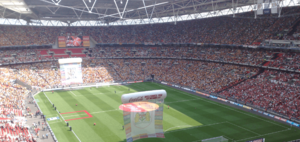
The 2005–06 season was Hull's first back in the second tier since 1991. They managed to stay in the league. Manager Taylor left and Phil Parkinson took over, but he struggled and was sacked in December 2006. Phil Brown became the new manager in January 2007. Local hero Dean Windass returned to the club on loan and helped them stay in the Championship.
Before the 2007–08 season, Windass joined permanently. New owners, led by Paul Duffen, bought the club. Hull City started slowly but gained momentum. Player Fraizer Campbell joined on loan and scored 15 goals. Hull finished 3rd and qualified for the play-offs.
In the play-off semi-finals, they beat Watford 6–1 over two games. On May 24, 2008, Hull City played Bristol City in the play-off final at Wembley Stadium. Dean Windass scored an amazing goal, and Hull won 1–0, reaching the Premier League for the first time in their history! It was one of the fastest climbs in English football, going from the fourth tier to the first in just five seasons.
Premier League and Back Again (2008–2016)
In the summer of 2008, manager Phil Brown signed new players like Geovanni, George Boateng, and Bernard Mendy to strengthen the team for the Premier League. Many people thought Hull City would be relegated. However, they started strong, beating Fulham 2–1 in their first game. Geovanni scored Hull's first-ever Premier League goal.
They had an amazing start, losing only one of their first nine games. This included surprising away wins against Arsenal and Tottenham Hotspur. At one point, Hull City was even tied for second place in the league! But their form dropped, and they only won two more games all season. On the final day, they lost to Manchester United but still avoided relegation because other results went their way.
In October 2009, chairman Paul Duffen resigned, and Adam Pearson returned. The club's financial problems affected their performance. In March 2010, manager Phil Brown was replaced by Iain Dowie. Dowie could not save the team, and Hull City was relegated on May 3, 2010.
Nigel Pearson became the new manager in June 2010. The club still had financial worries, so Pearson had to sign players without spending much money. In December 2010, Assem Allam became the new owner, promising to pay off the club's debts. This allowed Hull to buy players like Matty Fryatt. The team set a new club record of 14 away matches unbeaten. In November 2011, Pearson left, and former player Nick Barmby became manager. Barmby was sacked in May 2012 after criticizing the owners.
On June 8, 2012, Steve Bruce was appointed manager. He signed important players like Abdoulaye Faye, Sone Aluko, and Stephen Quinn. These players, along with loanees like Ahmed Elmohamady, helped Hull City push for promotion in the 2012–13 season. They were in the top two for much of the season.
Bruce led Hull back to the Premier League in a very exciting way on May 13, 2013. On the final day, they drew 2–2 with Cardiff City. Hull had to wait for the result of the Watford vs. Leeds United game. Leeds scored a late goal to win, which meant Hull City was automatically promoted!
After promotion, Bruce strengthened the squad with players like Tom Huddlestone and Jake Livermore. Hull City had some great results in the 2013–14 season, including a 3–1 home win over Liverpool and a huge 6–0 victory against Fulham. Huddlestone famously cut his hair after scoring, having promised to do so when he next scored a goal.
Hull City also had an amazing run in the FA Cup, reaching the final for the first time ever! They beat teams like Sunderland and Sheffield United to get to Wembley. On May 17, 2014, they played Arsenal in the final. Hull City shocked everyone by scoring two early goals, but Arsenal came back to win 3–2 in extra-time. Even though they lost, Hull City earned a spot in the Europa League because Arsenal had already qualified for the Champions League. This was Hull City's first time playing in a major European competition.
To prepare for Europe and the Premier League, Hull signed new players like Robert Snodgrass, Harry Maguire, and Andrew Robertson. On July 31, 2014, Hull City played their first European game, a 0–0 draw against AS Trenčín in Slovakia. They won the home leg 2–1, but were knocked out in the next round by K.S.C. Lokeren due to the away goals rule.
More players like Michael Dawson and Abel Hernández joined the team. Hull started the Premier League season well but then struggled and were relegated on the final day of the 2014–15 season.
Steve Bruce stayed as manager, and the team aimed for immediate promotion in the 2015–16 season. They reached the League Cup quarter-finals for the first time. Hull City finished in the play-offs again. In the final on May 28, 2016, a fantastic long-range goal from Mohamed Diamé helped them beat Sheffield Wednesday 1–0, securing their return to the top-flight!
Challenges and New Beginnings (2016–Present)
On July 22, 2016, Steve Bruce resigned as manager. His four years were very successful, with two promotions and an FA Cup final. However, fans were unhappy with the Allam family's ownership, especially their idea to change the club's name to Hull Tigers.
Fans were worried about the new season because no new players had been signed. A funny photo of only nine fit senior players on a pre-season tour showed how few players the club had. Mike Phelan became interim manager. Despite the problems, Hull City started the 2016–17 season with a surprising 2–1 win over reigning Premier League champions Leicester City. Phelan became permanent manager but was sacked in January 2017. Marco Silva took over but could not prevent relegation.
Leonid Slutsky became manager in June 2017 but left in December. Nigel Adkins then led the team to avoid another relegation. In the 2018–19 season, Hull City finished 13th, but Adkins resigned.
Grant McCann was appointed head coach in June 2019. The team started the 2019–20 season well, but then key players Jarrod Bowen and Kamil Grosicki were sold. Hull City struggled badly, losing 16 of their last 20 games, including an 8–0 defeat to Wigan Athletic. On July 22, 2020, Hull City was relegated to League One, the third tier, for the first time in 15 years.
Despite relegation, McCann stayed as head coach for the 2020–21 season. This was a good decision, as Hull City was promoted back to the Championship right away! They confirmed promotion on April 24, 2021, and a week later, they were crowned League One champions. This was the club's fourth league title and their first since 1966.
On January 19, 2022, Turkish businessman Acun Ilıcalı and his company Acun Medya bought Hull City, ending the Allam family's 11-year ownership. Grant McCann was sacked on January 25, 2022, and Shota Arveladze became the new head coach. He helped Hull stay in the Championship, but he was also sacked in September 2022.
On November 3, 2022, former player Liam Rosenior was appointed head coach. He improved the team's defense and away record, leading Hull to a 15th-place finish in the 2022–23 season. Rosenior had a very positive 2023–24 season, bringing the Tigers close to a play-off spot. However, he was sacked on May 7, 2024, because the owner wanted a more attacking style of play.
After Rosenior left, many players also moved on, including talented young players Jacob Greaves and Jaden Philogene. Tim Walter was appointed manager on July 1, 2024, but he was removed on November 27, 2024, after a poor run of results. Hull City was in the relegation zone at that time. Rubén Sellés became head coach on December 6, 2024. He helped the team avoid relegation, but he was dismissed on May 15, 2025. Sergej Jakirović became the new head coach on June 11, 2025.
Club Identity: Colours, Crest, and More
Team Colours
|
|
| Traditional home colours |
|
|
| 1935–36 home colours |
|
|
| 1946–47 home colours |
Hull City's main colours are black and amber. From the very beginning, they wore black and amber striped shirts with black shorts and socks. This is why the local newspaper, the Hull Daily Mail, nicknamed them the Tigers in 1905.
Over the years, the kit design has changed a few times. In the 1920s, white shorts were added. For the 1935–36 season, the team even wore blue shirts, white shorts, and blue and white striped socks to match the city's colours. But they soon went back to black and amber.
After World War II, because of limited supplies, they briefly wore paler blue shirts in the 1946–47 season. Later, the stripes were sometimes removed for plain amber shirts, but they often returned. In the 1980s, red trim was added. The 1990s saw some wild designs, including a full tiger-print shirt in 1992–93, which some loved and some hated! Today, they usually wear striped or plain amber shirts with black shorts and socks.
In 2024, for the club's 120th anniversary, they wore a special all-black kit with gold trim. Only 1,904 of these shirts were sold to fans, matching the year the club was founded.
Club Badge
At first, Hull City did not have a badge. In 1935–36, they added the three civic crowns of Kingston upon Hull to their shirts. Their first tiger head badge appeared in 1947–48, inside an amber shield.
Different versions of the tiger's head were used for many years. In 1975–76, the club used its initials, 'HCAFC', as the official badge. The famous tiger's head was officially recognized by the College of Arms that same year. In 1979–80, the badge went back to being the tiger's head.
Since then, the tiger's head has always been part of the badge, sometimes with the club's name and founding year. Before the 2014–15 season, the badge was changed to just the tiger's head and '1904' inside an amber shield. Many fans disliked this because it removed the club's name. Fans helped design a new badge, which was revealed in February 2019 and started being used in the 2019–20 season.
Kit Makers and Sponsors
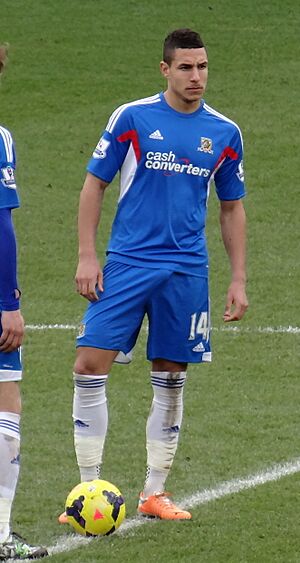
|
|
Home Stadiums
Hull City first played at the Boulevard, a rugby league ground. They then briefly moved to the Circle, a local cricket ground. In March 1906, Anlaby Road became the club's first permanent home. The Tigers played there until 1941, when World War II stopped football.
When football started again in 1946, Hull moved to the newly built Boothferry Park. This stadium was planned in 1929 but took a long time to build because of money problems and the war. Boothferry Park was Hull's home for 56 years.
In December 2002, they moved to the new KC Stadium. The old stadium was getting old, and new rules said top clubs needed all-seater stadiums. Moving showed Hull City's ambition, even though they were in the fourth tier at the time.
The new stadium is also home to the rugby team Hull F.C.. In 2006, it was named "Best Ground" at the first EFL Awards. The stadium's name changed to KCOM Stadium in 2016 and then to MKM Stadium in 2021 when MKM Building Supplies bought the naming rights.
Team Rivalries
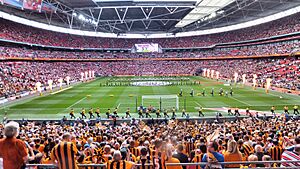
Hull City does not have one main rival like some other clubs. They play in the Humber derby against Grimsby Town and Scunthorpe United. However, many Hull fans see Leeds United as a bigger rival. Leeds fans, though, usually consider Manchester United their main rival.
Some older Hull supporters also see Sheffield United as rivals. This goes back to the 1983–84 season. Sheffield United got promoted instead of Hull because they scored more goals, even though both teams had the same points and goal difference. Hull City lost out on promotion in a very close and disappointing way.
Fanbase and Famous Supporters
Hull City has some famous fans, including actors Tom Courtenay and Omar Sharif. Courtenay grew up in Hull and introduced Sharif to the team. Sharif would even call the club's phone line from Paris to get score updates!
John Prescott, who was the Deputy Prime Minister of the United Kingdom from 1997 to 2007, also supported Hull City. He lived in Hull for most of his life. Filmmaker Mark Herman and actor Henry Priestman are also fans. They even made two songs about the Tigers and a short film. Singer Sinitta became a fan because of an ex-boyfriend from Hull.
Team Songs
Like many other football clubs, Hull City fans sing "Can't Help Falling in Love" by Elvis Presley before matches. A popular chant among fans is "You're getting mauled by the Tigers!" when the team is winning.
In February 1983, during a promotion season, famous fans Henry Priestman and Mark Herman released a song called "The Tigers are Back." They used the names 'Harry Amber' and 'Mark Black' (as 'Amber and Black'). The song helped raise money to pay the players' wages because the club was having financial problems.
Twenty-five years later, during another promotion season in 2007–08, 'Amber & Black' released a new song called "The City's on Fire." It was re-released before the 2014 FA Cup final.
Name Change Controversy
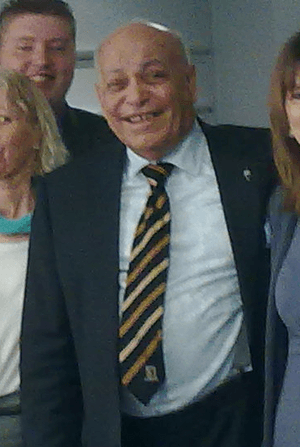
2013: The First Attempt
In August 2013, owner Assem Allam announced that the club had changed its official company name to "Hull City Tigers Ltd." He wanted the team to be known as "Hull City Tigers," removing "Association Football Club" from the name. The vice-chairman said "AFC" would stay on the badge for the 2013–14 season but would be removed later.
The Premier League said they had not been told about a change to the club's actual name. Allam wanted to rename the club simply "Hull Tigers" by 2014. He believed shorter names were stronger for marketing. He also said he disliked the word "City" because it was too "common" and used by many other clubs. Allam even said he would change Manchester City's name to "Manchester Hunter" if he owned them.
Allam said the name change would help the club make more money. This was after the Hull City Council refused to sell him the stadium land. He wanted to build a "sports park" with shops and cafes to help the club become financially stable.
Fans were against the name change. The chairman of the official supporters club was disappointed, even though he agreed Allam had saved the club from financial ruin. Fans marched in protest, holding a banner that said, "Hull City AFC: a club not a brand." Allam did not like the complaints, saying "nobody questions my decisions in my business."
In December 2013, Allam made a controversial comment about fans chanting "City Till We Die," saying, "They can die as soon as they want, as long as they leave the club for the majority who just want to watch good football." Fans responded by chanting, "We're Hull City, we'll die when we want." Manager Steve Bruce said the controversy created a "fantastic atmosphere" but also said he needed to talk to Allam because he did not understand the club's history.
On December 11, 2013, Hull City officially asked the Football Association (FA) to change its name to "Hull Tigers" for the 2014–15 season. The FA said it would talk to different groups, including fan groups, before deciding.
2014: Fans Fight Back
Some marketing experts supported the name change, saying it could help the club grow. However, David Stern, the head of the NBA in the United States, warned that club owners should listen to fans more.
On March 17, 2014, the FA committee suggested that the name change request should be rejected. Hull City said the FA was "prejudiced." The club then held a vote for season ticket holders. Critics said the questions were unfair because they did not allow fans to reject the name change while still supporting the Allam family as owners. Out of 15,033 season ticket holders, 5,874 voted. 2,565 voted for the change, 2,517 voted against, and 792 were not concerned.
On April 9, 2014, the FA Council officially rejected the name change application with a 63.5% vote. The owner, Assem Allam, said he would appeal, but there was no appeal process with the FA. On September 11, 2014, Allam said he was appealing to the Court of Arbitration for Sport and put the club up for sale because of the FA's decision.
In October 2014, Allam said he would "not invest a penny more in the club" unless he was allowed to change the name. He also said, "I have never been a football fan. I am still not a football fan. I am a community fan."
2015: Another Try
In March 2015, an independent group said the FA's decision to block the name change was "flawed." However, in July 2015, the Football Supporters Federation confirmed that an FA vote decided 70/30 against Hull City A.F.C. changing its name.
Club Finances
In 2009, auditors found that money had been loaned from the club to owner Russell Bartlett's other companies. Bartlett then gave the club a loan to balance things out.
The company that owns Hull City, "The Hull City Association Football Club (Tigers) Ltd," is owned by Allamhouse Limited. This company is based in Jersey and is owned by the Allam family.
In July 2013, Hull City's financial reports showed a £25.6 million loss. Another company owned by the Allam family, Allam Marine, used Hull City's tax losses to reduce its own tax payments.
Players and Staff
Current Team Squad
|
|
Players on Loan
|
Under-21s Team
Hull City's development squad plays in the Professional Development League North Division. They usually play their home games at the LNER Community Stadium in York.
Under-21s on Loan
|
Under-18s Team
|
|
Team Captains Through the Years
This is a list of all the official club captains Hull City has had since the 1997–98 season. Temporary captains are not included.
|
|
Player of the Year Awards
This is a list of all the players who have won Hull City's Player of the Year award since the 1974–75 season.
|
|
|
Hull City Hall of Fame
In 2017, Hull City started its own Hall of Fame to honor club legends. The first players were chosen in February 2018.
|
|
Hull City Ladies F.C.
Hull City Ladies F.C. is a separate women's football club. They are not officially part of Hull City A.F.C., but they share similar colours and a badge. They are known as The Tigresses and play their home games in Barton-upon-Humber.
Club Management
Owners and Board Members
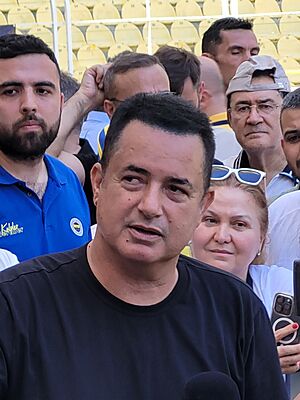
|
Coaches and Staff
Managers Through History
This list includes only professional, competitive matches. Interim managers are not included.
|
Club Records and Statistics
Player Appearances
Andy Davidson has played the most games for Hull City, with 579 appearances in all competitions. Garreth Roberts is second with 487 games, and Chris Chilton is third with 477.
The youngest player to make their debut for the club was Matt Edeson, who was 16 years and 60 days old in 1992. The oldest player to debut was Andy Hessenthaler at 39 years and 168 days old in 2005. However, Steve Harper was the oldest player to ever play for the Tigers, at 40 years and 60 days old in 2015.
Theodore Whitmore from Jamaica holds the record for the most international games played while at Hull City, with 28 caps between 1999 and 2002.
Goal Scoring Records
Chris Chilton is Hull City's all-time top scorer, with 222 goals in all competitions between 1960 and 1971. Ken Wagstaff is second with 197 goals.
The most goals scored by a single player in one game is six, achieved by Duane Darby against Whitby Town in an FA Cup match in 1996. The record for most goals in a single season is 42, scored by Bill McNaughton in the 1932–33 season.
Biggest Wins and Losses
Hull City's biggest win was an 11–1 victory over Carlisle United in 1939. Their biggest away win was 8–2 against Stalybridge Celtic in the FA Cup in 1932.
Hull has lost 8–0 twice in their history. First, against Wolverhampton Wanderers in 1911, and then over a century later against Wigan Athletic in 2020.
Attendance Records
The highest number of fans at a Hull City game was 89,345. This was for the 2014 FA Cup final against Arsenal at Wembley Stadium in 2014.
The highest home attendance for Hull City was 55,019 at Boothferry Park in 1949 for an FA Cup game against Manchester United. At the MKM Stadium, the record is 25,030, set in 2010 against Liverpool.
Player Transfers
The largest amount Hull City has ever paid for a player is about £13 million for Ryan Mason in 2016. The largest amount the club has received from selling a player is £22 million for Jarrod Bowen in 2020.
European Football History
|
Club Achievements
League Titles and Promotions
- Championship (Second Tier)
- 2nd place promotion: 2012–13
- Play-off winners: 2008, 2016
- Third Division North / Third Division / League One (Third Tier)
- Champions: 1932–33, 1948–49, 1965–66, 2020–21
- 2nd place promotion: 1958–59, 2004–05
- 3rd place promotion: 1984–85
- Fourth Division / Third Division (Fourth Tier)
- 2nd place promotion: 1982–83, 2003–04
Cup Competitions
- FA Cup
- Runners-up: 2013–14
- Associate Members' Cup
- Runners-up: 1983–84
- Watney Cup
- Runners-up: 1973
See also
 In Spanish: Hull City Association Football Club para niños
In Spanish: Hull City Association Football Club para niños


